Podcast
Questions and Answers
What is the first cell type to arrive at the site of a muscle injury during the necrosis phase?
What is the first cell type to arrive at the site of a muscle injury during the necrosis phase?
- Fibroblasts
- Neutrophils (correct)
- Macrophages
- T-lymphocytes
Which phase of muscle healing begins 6-8 weeks after an injury?
Which phase of muscle healing begins 6-8 weeks after an injury?
- Hemostasis
- Inflammation
- Degeneration
- Regeneration (correct)
What happens if the basement membrane is not intact after a muscle injury?
What happens if the basement membrane is not intact after a muscle injury?
- Enhanced angiogenesis occurs
- Fibrosis is likely to result (correct)
- Muscle fibers can easily regenerate
- Increased myofibrogenesis takes place
Which of the following is NOT one of the effects cytokines have on muscle cells during repair?
Which of the following is NOT one of the effects cytokines have on muscle cells during repair?
What is the primary role of macrophages during the inflammation phase of muscle repair?
What is the primary role of macrophages during the inflammation phase of muscle repair?
What is the primary role of neutrophils during the degeneration phase of muscle injury repair?
What is the primary role of neutrophils during the degeneration phase of muscle injury repair?
Which statement best describes the role of cytokines in muscle repair?
Which statement best describes the role of cytokines in muscle repair?
During inflammation after a muscle injury, which cells dominate the repair process after the initial response of macrophages?
During inflammation after a muscle injury, which cells dominate the repair process after the initial response of macrophages?
What consequence results from an intact basement membrane following a muscle strain?
What consequence results from an intact basement membrane following a muscle strain?
What is one of the primary functions of macrophages during the muscle injury repair process?
What is one of the primary functions of macrophages during the muscle injury repair process?
Flashcards are hidden until you start studying
Study Notes
Skeletal Muscle Injury Repair
- Process of Repair After Muscle Strain or Contusion
- Hemostasis initiates injury response, followed by hematoma formation.
- Degeneration Phase
- Necrosis occurs, with neutrophils as the first responders to the injury site.
- Chemotactic agents are released to attract inflammatory mediators.
- Inflammation Phase
- Starts within 24-48 hours post-injury.
- Phagocytosis occurs to clear cellular debris.
- Macrophages stimulate satellite cells to:
- Migrate to injury site.
- Differentiate into necessary cells.
- Release various cytokines aiding the healing process.
- T-lymphocytes take over as macrophages diminish, releasing additional cytokines.
- Regeneration Phase
- Takes place approximately 6-8 weeks after injury.
- Remodeling occurs following regeneration to restore muscle structure.
- Fibrosis Potential
- May develop as a result of injury, leading to less functional muscle.
Role of Basement Membrane in Muscle Healing
- The basement membrane's integrity is crucial for successful regeneration.
- Satellite cells rely on the basement membrane to:
- Divide and maintain structural support.
- Combine with other myogenic cells for repair.
- Fuse with remaining muscle fibers to restore function.
- Damage to the basement membrane results in fibrosis, which:
- Compromises structural integrity of muscle.
- Reduces functional capacity.
- Increases likelihood of subsequent re-injury.
- Satellite cells rely on the basement membrane to:
Effects of Cytokines on Satellite Cells and Muscle Cells During Repair
- Cytokines play critical roles in muscle cell repair, including:
- Enhancing resistance to oxidative stress, promoting cell survival.
- Blocking myofibrogenesis to facilitate improved muscle healing.
- Stimulating proliferation, leading to cell division.
- Inducing differentiation, allowing cells to fuse with existing myofibers.
- Promoting angiogenesis to ensure adequate vascular supply to new muscle cells.
Skeletal Muscle Injury Repair
- Process of Repair After Muscle Strain or Contusion
- Hemostasis initiates injury response, followed by hematoma formation.
- Degeneration Phase
- Necrosis occurs, with neutrophils as the first responders to the injury site.
- Chemotactic agents are released to attract inflammatory mediators.
- Inflammation Phase
- Starts within 24-48 hours post-injury.
- Phagocytosis occurs to clear cellular debris.
- Macrophages stimulate satellite cells to:
- Migrate to injury site.
- Differentiate into necessary cells.
- Release various cytokines aiding the healing process.
- T-lymphocytes take over as macrophages diminish, releasing additional cytokines.
- Regeneration Phase
- Takes place approximately 6-8 weeks after injury.
- Remodeling occurs following regeneration to restore muscle structure.
- Fibrosis Potential
- May develop as a result of injury, leading to less functional muscle.
Role of Basement Membrane in Muscle Healing
- The basement membrane's integrity is crucial for successful regeneration.
- Satellite cells rely on the basement membrane to:
- Divide and maintain structural support.
- Combine with other myogenic cells for repair.
- Fuse with remaining muscle fibers to restore function.
- Damage to the basement membrane results in fibrosis, which:
- Compromises structural integrity of muscle.
- Reduces functional capacity.
- Increases likelihood of subsequent re-injury.
- Satellite cells rely on the basement membrane to:
Effects of Cytokines on Satellite Cells and Muscle Cells During Repair
- Cytokines play critical roles in muscle cell repair, including:
- Enhancing resistance to oxidative stress, promoting cell survival.
- Blocking myofibrogenesis to facilitate improved muscle healing.
- Stimulating proliferation, leading to cell division.
- Inducing differentiation, allowing cells to fuse with existing myofibers.
- Promoting angiogenesis to ensure adequate vascular supply to new muscle cells.
Studying That Suits You
Use AI to generate personalized quizzes and flashcards to suit your learning preferences.




